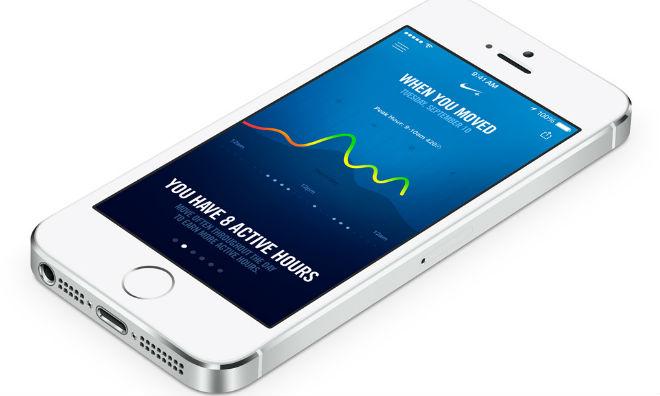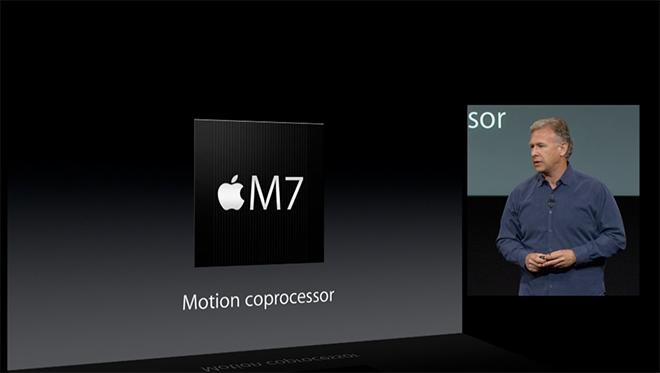Apple's inclusion of a motion coprocessor in the iPhone 5s will likely spawn a whole new generation of intuitive, user-friendly fitness apps, and may indicate where the company's future devices and services are headed.
In unveiling the iPhone 5s, Apple marketing chief Phil Schiller pointed out the addition of a "motion coprocessor," dubbed the M7 chip, which works with the new A7 processor to handle data from the smartphone's assorted sensors. Even when the device is in sleep mode, the M7 gathers information from the gyroscope, accelerometer, compass, and other sensors to continually measure a user's activity, all with power consumption levels much lower than the A7.
"It takes advantage of all these great sensors and it continually measures them without having to wake up the A7 chip," Schiller said, noting that, even in sleep mode, the device could tell if a user is "stationary, running, walking, or driving."
The iPhone 5s will also be able to change the behavior of apps depending on the user's motion. When driving, for instance, a navigation app may be called on to provide driving directions. When the user gets out of their car and starts walking, the navigation app could switch the type of direction information appropriately, all without waking the device.
When the iPhone 5s is brought out of sleep, the M7 can feed the gathered information to a compatible fitness-oriented app. This means that apps like those supplied by Nike will be able to constantly monitor a user's activity levels with little effect on battery life.
Nike, in fact, has built the first app to take advantage of the M7 coprocessor. Schiller noted the capabilities of Nike+ Move, an app that uses the M7 just as described above. Schiller left open the possibility that future apps will also access the iPhone 5s' motion data.
Aside from detailing its capabilities, Schiller did not reveal how Apple plans to use the chip going forward. While it may may have some functionality overlap with existing health monitors like Nike's FuelBand, or the heart rate-monitoring Withings Pulse, use scenarios will likely keep the third party accessory market relevant for some time.
Some observers have noted the possibility that Apple could include the M7 into the design of its suspected smart watch device, referred to by many as the "iWatch." Apple is said to have been aggressively hiring for the so-called smart watch, and rumors hold that the device will be packed with biometric sensors, much like Nike's FuelBand. A built-in motion coprocessor in such a device could have the effect of greatly differentiating Apple's rumored offering from what many think will be a crowded smart watch market.
The iPhone 5s follows quickly in the footsteps of another flagship device with a focus on motion sensing, the Moto X from Google-owned Motorola.
In revealing that device, however, Motorola did not stress the fitness applications of the built-in, low-power motion sensors. The company did, though, showcase such features as the phone automatically displaying information on its screen when it detects itself being removed from a pocket. Motorola's device can also automatically switch into camera mode when it detects it is being moved into a photo-taking position.
No such features were announced for the iPhone 5s, but Apple can conceivably add similar functionality via updates to iOS.
Apple's iPhone 5s will go on sale alongside the iPhone 5c on Sept. 20. Unlike previous launches of Apple's flagship device, as well as this year's iPhone 5c, the 5s will not have a preorder period, meaning it will only become available on the 20th at retail locations and online.
 Kevin Bostic
Kevin Bostic








-m.jpg)






 Charles Martin
Charles Martin
 Christine McKee
Christine McKee
 Wesley Hilliard
Wesley Hilliard
 Malcolm Owen
Malcolm Owen
 Andrew Orr
Andrew Orr
 William Gallagher
William Gallagher
 Sponsored Content
Sponsored Content







41 Comments
Since the 5S does no have a pre-order, wonder what the delivery date would be if I purchase it online on Sep 20?
Depends on when you purchase it that day.
The iPhone 5s will also be able to change the behaviour of apps depending on the user's motion. When driving, for instance, a navigation app may be called on to provide driving directions. When the user gets out of their car and starts walking, the navigation app could switch the type of direction information appropriately...
This was the part where my jaw hit the floor.
[quote name="Dunks" url="/t/159488/apples-new-m7-motion-coprocessor-to-empower-new-breed-of-fitness-apps#post_2395197"] This was the part where my jaw hit the floor. [/quote] It makes Apples purchase of all of those small mapping Apps make more sense. Most of this functionality will probably hit iOS 8 and be prominately featured on the iPhone 6 with backwards compatibility with the 5S
This could make those "sleep cycle alarm" apps efficient enough to not necessarily need a power connection all night long. It could also help GPS apps (including weather alerts and geofences), making the even lower-power than Location Services already is, by waking them up to check for an updated location only if movement has been sensed. After all, you can't change coordinates without also jostling your phone. I'm not sure what's left to put in a watch!